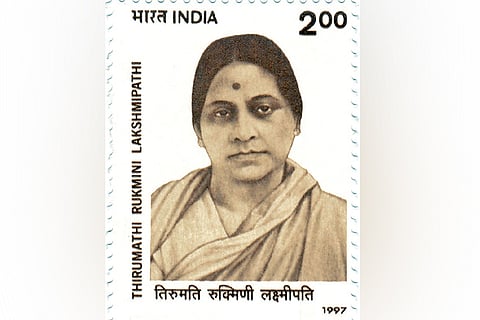

Chennai
But surprisingly, while Dandi March had no women participants, the Vedaranyam march in Tamil Nadu 90 years ago, had four women marching from Trichinopoly (now Tiruchi) to Agastyanpalli.
The women underwent all the travails of the others, including lathi blows and starvation organised by the British commissioner Thorne, who even made it a penal offence for villagers to feed the marching satyagrahis. One of those valiant ladies was Rukmini Lakshmipathi.
Hailing from a landlord’s family (her guardian being the Dewan of Cochin state), she was in the first batch of forty-one students in Women’s Christian College, Madras.
A girl with progressive ideals, she persisted in an inter-caste marriage with widowed Lakshmipathi, an MMC trained doctor who had turned his interests to Indian native medicine. They met in a library opposite one of his clinics.
The wedding created ripples in Madras society. Her short-lived son was named Emden Srinivasa Rao, for he was born sometime around the Madras bombing. Soon she was a mother to four daughters and another son. But then her eyes turned to nationalism.
Rukmini Lakshmipathi joined the Indian National Congress in 1923 and played an active role in organising the Youth League of the Congress. A late entrant into politics, at the age of 31, her first act was to donate all her jewellery to the Harijan welfare fund. Her political concentration was on impressing upon the folks the need to wear Khadi, child marriage opposition and boycotting liquor. In 1926, she was deputed by the Congress to the International Women’s Conference on Suffrage in Paris (apt because Madras women could vote as early as 1921).
But then came the confrontation with the British and Rukmini did not hesitate. Opposing the Simon Commission vehemently and celebrating a hypothetical independence day (January 26th) by raising the Tricolour in Triplicane brought her into the forefront of the freedom fight.
In 1930, Gandhiji gave a call for the nation to rise and make salt, thus breaking the salt tax law and defying the mighty British empire. To be chosen as one of the 99 satyagrahis for the Vedaranyam march, one had to be merit worthy in a satyagrahi scale. She fitted. Rukmini, by then a vice-president of Tamil Nadu provincial Congress Committee, marched to Vedaranyam to break the salt laws. Halfway through the march, she reportedly made a lightning trip to see her son in Madras, down with food poisoning. But within a few hours, she returned to the march.
As the team neared the sea, the British police turned to violence. Rukmini, running around the marchers to keep the flock together, weathered the blows meant for others. When finally overwhelmed by the police, she was dragged away from a pile of salt made by the satyagrahis, which she was trying to defend from the police. She was the first woman in the nation to be arrested under the salt laws and sentenced to undergo imprisonment for one year.
Interestingly, Rukmini Lakshmipathi’s only son was a cadet on a British ship, where he was taking a daily oath of loyalty to the British emperor. When questioned on the anomaly in her family, Rukmini retorted that with India on the verge of sovereignty, highly trained professionals would be needed soon for the fledgling nation. After many more agitations and jailings, Rukmini entered the legislative assembly in a bypoll and became a deputy speaker. At that moment, she was also holding the post of a corporator in the Madras Corporation.
However, the posts were short-lived. Gandhi called for the individual satyagraha movement where a freedom fighter chosen by the Mahatma himself would stand on a bench in an important spot in the town and read out a single line opposing the British government. When arrested they would plead guilty and make a memorable statement. Rukmini was one of the 21 chosen for Madras for January 1941 (there was a Pongal holiday for the satyagraha too). The statement she made in court was: “Let the women in India follow the leadership of Mahatma Gandhi and maintain the honour and dignity of their Motherland.” Not only was she arrested, but also was she stripped of her people’s representative posts.
However, independence was fast approaching, and in 1946, elections were held to elect a legislature to lead the nation into its freedom. Rukmini contested in the women’s constituency of Madras and won. She became the Minister for Public Health in the T Prakasam Ministry in Madras. This was befitting because her family and especially her husband Asantha was a pioneer of Ayurveda in public health. Rukmini herself was a strong advocate of the revitalisation of Indian medicine procedures such as Ayurveda and homoeopathy. Rukmini was chosen to hoist the national flag in the Royapettah Congress office to commemorate the Independence Day.
Rukmini is remembered today on an important road with her statue. Also, the Women’s Christian College has an annual lecture in her memory, remembering the student of the first batch who served her country well.
— The author is a historian
Visit news.dtnext.in to explore our interactive epaper!
Download the DT Next app for more exciting features!
Click here for iOS
Click here for Android